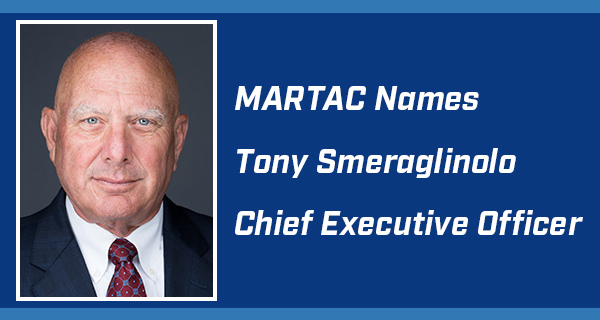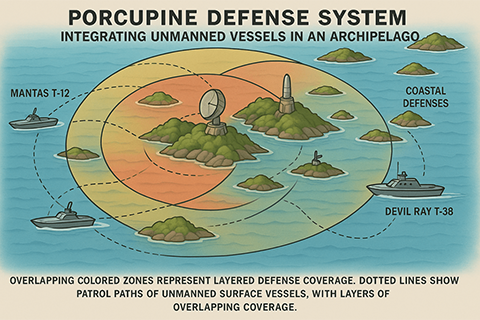Novel Concepts for Amphibious Force Resupply
- July 01, 2019
The United States continues to place a premium on amphibious forces as part of its global response
capabilities. Unmanned surface vessels have recently been tested which offer a significant advance in
the ability of amphibious forces to conduct important ship-shore resupply from standoff distances
George Galdorisi
RUSI Defence Systems,
28 June 2019
The United States Navy has made a substantial investment in forces optimized for amphibious assault. According to the latest Congressional Research Service Report, Navy Force Structure and Shipbuilding Plans: Background and Issues for Congress,US Navy-Marine Corps amphibious assault forces have remained relatively robust as the size of the US Navy has shrunk from 594 ships in 1987 to 272 ships today. And as the aforementioned Congressional Research Service report explains, US Navy
expeditionary strike groups, built around a large deck amphibious ship, make up a substantial percentage of the US Navy’s current fleet – and the blueprint for the future fleet the Navy is building maintains and even increases that percentage of amphibious ships.
In the almost two decades since the 9/11 attacks, the US Marine Corps has been heavily engaged in Iraq and Afghanistan and has not routinely embarked in the US Navy’s amphibious ships. Today, the Marines are back to sea and are working with their navy partners to ensure that the country’s amphibious assault forces (more appropriately, expeditionary assault forces) remain important to the US Navy and Marine Corps operational calculus.
The reason for the prominence of these expeditionary assault forces is clear. These naval expeditionary formations—built around a large-deck amphibious assault ship, an amphibious transport dock, and a dock landing ship—have been the ones used extensively for a wide array of missions short of war: from anti-piracy patrols, to personnel evacuation, to humanitarian assistance and disaster relief, to other missions. And where tensions lead to hostilities, these forces are often the only ones able to give the US military a forcible entry option.
In his keynote remarks at National Defense Industrial Association Expeditionary Warfare Conference, in Annapolis Maryland in October 2018, Lieutenant General David Berger, Commander of the Marine Corps Combat Development Command (and nominee to be the next Commandant of the US Marine Corps), put it this way: “We need to be prepared for large-scale amphibious operations. We might do it differently in the future, but we can’t ignore it.
This emphasis on expeditionary operations is not limited to the US military. A recent article in US Naval Institute News, “New High-End Amphibious Warfare Tactics Tested at BALTOPS 2019,” noted that new tactics evolved through the NATO Amphibious Leaders Expeditionary Symposium (NALES) series were the primary focus of this multinational exercise, which included participation by eighteen nations, dozens of ships and over 8,600 personnel. As an article in Defense News, “Eighteen-nation BALTOPS exercise wraps up in Germany,” described it: Belgium, Denmark, Estonia, France, Germany, Latvia, Lithuania, the Netherlands, Norway, Poland, Portugal, Romania, Spain, Turkey, the United Kingdom, and the United States, as well as NATO partner nations Finland and Sweden, all participated in BALTOPS 2019, one of the largest exercises in Northern Europe. Of particular interest to readers of RUSI Defence, BALTOPS 2019 was one of the first major training opportunities for the British-led Joint Expeditionary Force, which included 3,000 personnel from several NATO and partner countries.
It is clear that many nations – NATO and partner nations in particular – intend to continue to place an emphasis on expeditionary operations. And within NATO, the United States is the nation with the most amphibious ships, as well as Navy and Marine Corps personnel, dedicated to this mission. Therefore, many nations take a keen interest in what the U.S. military is doing as it evolves its expeditionary forces to meet the threats of the 21st Century.
Because of their long hiatus from the US Navy’s amphibious assault ships, the US Marine Corps has been especially proactive in organising many amphibious exercises, experiments and demonstrations to investigate emerging technologies (often commercial, off-the-shelf technologies) to enable expeditionary strike formations to prevail in the face of a determined adversary possessing robust A2/AD capabilities.
Many of these new technologies have served to support high-end warfighting tasks and deal with many of the adversary A2/AD capabilities that Kaushal and Watling’s January 2019 article ‘Amphibious Assault is Over’ discussed in detail. However, there are other technologies that may be useful in dealing with some of the more mundane – but necessary – aspects of supporting troops on a hostile beachhead.
One recent US Navy–Marine Corps exercise, Joint Exercise Valiant Shield 2018, focused on using offthe-shelf technology to perform the logistics function, something of critical importance to Marine Corps warfighters. Of those technologies, one that showed great promise was using small unmanned surface vehicles to deliver supplies to Marines on the beach.
Overseen by Commander Marine Forces Pacific (MARFORPAC), the exercise looked to support Marines on the beachhead during the juncture of an amphibious assault where troops must move off the beach and inland. As. Kaushal and Watling highlighted in their article, ‘the capacity of Marines to push inland must depend on the security of their logistical support’. While their article focused specifically on the US Marine Corps, the importance of logistical support is critical to any military conducting amphibious operations.
As just one indication of the importance of logistics to any amphibious operation, during the February 2019 US Naval Institute/Armed Forces Communications and Electronic Association ’West’ Symposium, Brigadier Arthur Pasagian, USMC, Commander, Marine Corps Systems Command, noted, “Logistics is a key enabler for all we do.” Later during the West Symposium, Brigadier General Christian Wortman USMC, Commanding Officer Marine Corps Warfighting Lab, connected this need for logistics support to unmanned vehicles when he noted “We need long-range, autonomous capabilities to deliver our logistics.”
Exercise Valiant Shield: Demonstrating Logistics Resupply Via Unmanned Systems
During Valiant Shield 2018, MARFORPAC used unmanned surface vehicles (USV) to resupply the landing force. The expeditionary force commander used a catamaran-style hull 12-foot MANTAS USV to provide rapid ship-to-shore logistics resupply. While this small, autonomously operated USV carried only 120 pounds of cargo, the proof-of-concept worked and successfully demonstrated that USVs can safely and effectively resupply troops ashore.
Using unmanned vehicles could be a game-changer for expeditionary assault forces. Beyond taking operators out of harm’s way, using USVs for this mission frees manned craft for other missions. Having a continuous, pre-programmed logistics resupply process to perform one of the dull, dirty and dangerous functions that are crucial in an amphibious assault gives the commander one less thing to worry about in the chaotic environment of an amphibious operation.
While the proof-of-concept with a 12-foot MANTAS USV worked, resupply in 120-pound increments is far less than what is required by troops on the beach, so larger USVs are needed. For this reason, the maker of the MANTAS family of USVs (Maritime Tactical Systems, Inc.) has been challenged by the US Navy and US Marine Corps to scale-up the 12-foot USV and develop a larger proof-of-concept USV. Larger MANTAS USVs, ranging from 38-feet to 50-feet long, are being designed for further review by US Navy and Marine Corps officials.
The basic specifications of the 38-foot MANTAS (T38) indicate that it can provide a steady, continuous stream of logistics support to Marines on the beach. The T38 travels at a cruise speed of 25 knots with a burst speed of 80 knots and weighs 6,500 pounds. The T38 can carry a payload of 4,500 pounds.
What This Could Mean for Expeditionary Logistics
Logistics resupply is one of the dull, dirty and dangerous functions important in an amphibious assault that can readily be offloaded to unmanned systems and thus keep humans out of harm’s way. But what would a concept of operations entail to successfully perform this function?
An amphibious formation typically stands no more than 15–25 nautical miles off the beach being assaulted. Using a notional stand-off distance of 20 nautical miles, an amphibious formation equipped with four T38s traveling at their cruise speed of 25 knots could deliver 18,000 pounds of material from the amphibious ships to the beach per hour, allowing for the short time needed to load and unload the craft. Multiply that by 24 hours and a build-up of well-over 400,000 pounds of vital material per day is achieved, enough to support a battalion (500-800 men) of troops ashore.
Over 2,500 years ago, Sun Tzu noted in The Art of War, ‘The line between disorder and order lies in logistics’. Those states and navies with significant amphibious assault forces would be well served to leverage what the US Navy and Marine Corps have already demonstrated in exercises such as Valiant Shield 2018 and explore the advantages of using USVs to resupply troops ashore
George Galdorisi
Director of Strategic Assessments and Technical Futures at the U.S. Navy’s Information Warfare
Centre. His 30 years of service in the U.S. Navy included three tours in command positions in the
amphibious assault Navy where he participated in numerous multinational amphibious exercises





